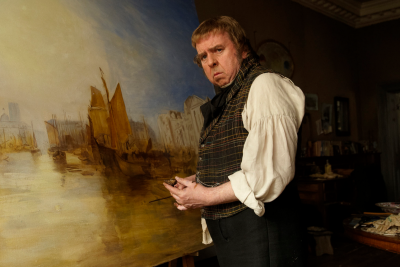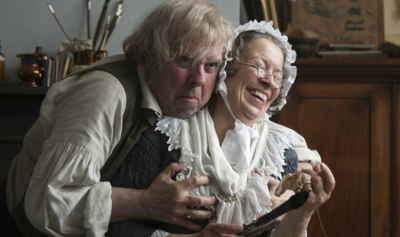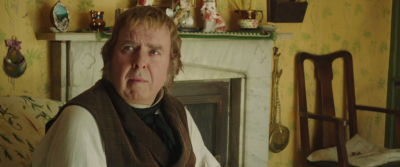Undoubtedly known best to the younger generations of the world for his role as Peter Pettigrew aka Wormtail in the “Harry Potter” franchise, for stage-goers and adult movie-goers alike, Timothy Spall is so much more. A former member of the Royal Shakespeare Company, Spall spent the early days of his career easily vacillating between stage and television, at one point heading up his own drama series, before finding sweet collaboration with filmmaker Mike Leigh while also working with directors like Ken Russell, Clint Eastwood, Bernardo Bertolucci and Kenneth Branagh. Now, Spall embarks on his seventh collaboration with Mike Leigh in MR. TURNER.
Born in England shortly before the Revolutionary War with the Colonies and living to the ripe old age of 76 years, Joseph Mallord William “J.W.” Turner was best known as an English Romantic landscape painter. Credited as laying the foundation for Impressionism, on his death, Turner left more than 19,000 watercolors, drawings and oil paintings to the British people. While most of Turner’s most famous works are oils, among them, “ The Fighting Temeraire Tugged to Her Last Berth to be Broken Up”, painted in 1838, he is considered one of the great masters of British watercolor landscapes. Often referred to as “the painter of light”, it comes as no surprise to many that on his deathbed on December 19, 1851, his final words were “The sun is God.” But just who was J.W. Turner, the man? That is a question writer/director Mike Leigh endeavors to answer with his astounding film, MR. TURNER. And it’s safe to say that were it not for his casting of Timothy Spall as Turner, the film might only not have been made, but would certainly not be the stunning work that it is. As for Spall, this is an Oscar-worthy performance if ever there was.
Timothy Spall’s enthusiasm for MR. TURNER and for working with Leigh is unabashed. Describing the experience as “a great journey to go on”, Spall is also quick to admit “For him to have asked me to have done it in the first place was great. . . . [But] I knew it wasn’t going to be a conventional journey.” As Spall puts it, Leigh “has a very particular modus operandi and a formula that he’s invented, which is, you bring the work. The work is made up basically. You start with nothing. He’s very, very blatant about that. He says, ‘Here we all are together. In a year’s time, I hopefully will have a film.’” While most of Leigh’s films are contemporary pieces, MR. TURNER marks the third period piece, but his second based on a real person.
Expounding on Leigh’s technique, Spall explains that “you come to the characters through improvisation. You create a proto-human being out of people that you’ve encountered in your life, and you start building up this person and start becoming this person. . .Then, you start to form that person; in this case trying to make this person reach towards the research that you’re discovering about the character of Turner.” For Spall personally, his real work comes as he spends “a helluva lot of your time reading, discovering, observing, going through the work, and looking at the extant material, the eyewitness accounts of what [Turner] looked like and what he spoke about” with the goal being “You’re trying to form this human being that will fit the bill. The human being becomes a hand and the research is a glove, and you try to bring this character together into the research, mesh it and create this person that is the sum total of all that endeavor.”
As the character starts to come together, “what you’re going to do is you create a whole parallel universe in which you start becoming Turner’s world and you start living in real time in this world in a rehearsal situation. You start putting on the clothes. We built a whole studio that we could rehearse in. It’s an organic process. You invent this massive lagoon of information without any pressure to do anything apart from create this person, a person that might fit the bill that is the character that is emerging from the research. . . And it’s the sum total of that in an essence.”
When it comes to achieving or creating the physicality of the character, for Spall paints an indelible portrait. “Again, that grows out of the organic process of building up the character. . .these people which are the prototypes that become the composite, the amalgam. You alchemize these characters into one person as it were. And so, all the time you’ve got an eye on the physicality.” With J.W. Turner, “ We looked at pictures and we read about descriptions of what he was physically. He had this certain look, this certain hunched quality, a certain implosive nature. We worked on that right from the beginning; that he was physically very particular. . .We did him right from when he was a young man, and we got up and walked about and did him, and worked up until he got older and older. Obviously, the film is about the last 25 years of his life, so as he ages as he gets this odd swagger that turns into this even more odd position. He was very hunched and oddly physical, almost a person that was, in a sense, implosive in his nature and implosive in his body, but actually explosive in his expression when he comes to his art. It was almost like we were trying to build a character that was sucking everything in so he could shoot it all out. That’s how he expressed himself.” The result is mesmerizing, with each movement, each nuance, each expression, just one more meticulous brush stroke by Spall.
Finding J.W. Turner to be a man “who had this massive understanding, this ability to see things and feel them, but rather than share them, what he does with them, we discovered, and as the character grew organically, he sees them, understands them, computes them and sucks them inside himself. . . he’s very, very sensitive, but chooses not to express himself.” Given that tenor of the character, Spall embarked on a series of almost “grunts” or various sounds as a means of expressiveness for Turner, defining him as “somebody who is getting it, seeing it, and feeling it [and] could say a million things. But rather than say a million things, he just goes, ‘Humph, humph.’ He pulls it in and packs it in there and shoves it down there. It’s almost like naturally he stores it in this pressure cooker that comes ‘whoof’ out the other end.” Despite the use of these “grunts”, Spall relates that “there were times when [Turner] was very expressive, and he speaks a lot more than people actually realize in this. He actually speaks in a very colorful tone. There’s a lot more speech in this. People come away left with the fact that he only communicates with grunts. I know he speaks a lot because I had to learn those lines and speak them. He had quite a sophisticated, convoluted, baroque way of talking. That is reported.”
Noting that Turner was a Professor of Perspective and would often give lectures, “there are reports that he would be one time very expressive, as he is in the Academy. He’s very convivial and he’s very open, and sociable. But there are also reports where he would sit and he would stand, and people would ask him questions.” A Turner anecdote Spall found particularly amusing, and which is depicted within the film, involved the great French artist, Eugene Delacroix who “showed [Turner] around his studio and in his reportage, Turner just looks at him and goes, ‘Humph. Fine. Humph. Yup. Humph. Yeah.’ And then he left.”
Interesting is that in Spall’s research into Turner, he found there is much written about the man, so much so that it allowed Spall to embrace the incongruities and ambiguities of his character with subtlety and nuance. “There are reports about how he spoke, about how he was; and they’re wonderfully contradictory, as are all the different portraits of him. Considering he was knocking about with some of the finest portrait painters in the world, he didn’t like being painted. He didn’t like people knowing much about him at all. He was incredibly secretive. He was incredibly determined that people never knew much about his private life and that’s what the film has elements of, about the secrecy nobody knew about, like Sophia Booth (Turner’s landlady in his beloved seaside town of Margate and his eventual partner until Turner’s death in 1851). Nobody knew that he had children. Nobody knew this. He was very, very secretive.”
But the one part of Turner that wasn’t a secret was his ability as an artist. One of the few artists successful throughout his life, painting is an important part of any performance or characterization of him. For Spall, that meant immersing himself even deeper into the role by taking painting lessons from artist and portraitist Tim Wright. As he tells it, “Mike [Leigh] told me that he was going to pull the trigger on a project. He said, ‘We’re going to make a Turner film.’ This was in 2010. ‘I’m going to get the money. I don’t know what it’s going to be about, but it’s going to be about Turner. Don’t get excited because it’s three years’ time and it might not happen anyway, but why don’t you go away and learn how to paint for a couple of years?’ So I said, ‘Alright.’ In between other jobs, I would go back to Tim Wright. He’s a very talented portraitist and teacher, and he taught me. And basically he gave me a personal fine art foundation course where we did all the elements.”
Calling Leigh “the great original dramatist”, Spall embraces that modus operandi of Mike Leigh’s filmmaking. “What happens is there is a point in a Mike Leigh film where all these things just come together. You chuck it all in a pot. All of this research, all of this trying to create this character, there comes a point, and thankfully it happens, where the character starts happening itself. It’s almost like you have chucked all this stuff in the stew and then the stew starts telling you what to do. . .” Everything came together perfectly in the stew that is MR. TURNER.
With MR. TURNER now behind him, when asked about the future, Spall is humorously pragmatic. Humbly admitting that his work with Tim Wright “culminated in me ending up attempting a couple of copies. We ended up doing the one, “Snow Storm – Steam-Boat Off a Harbour’s Mouth”, which I’ve got on my wall at home. I look at it and I think, ‘How the hell did I do that?’!” How the hell indeed, Timothy Spall, how the hell indeed.


















